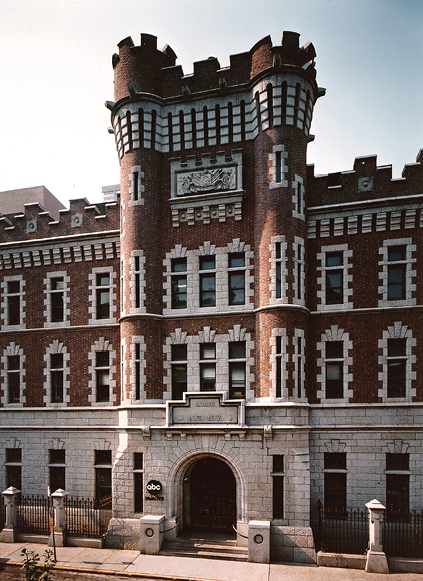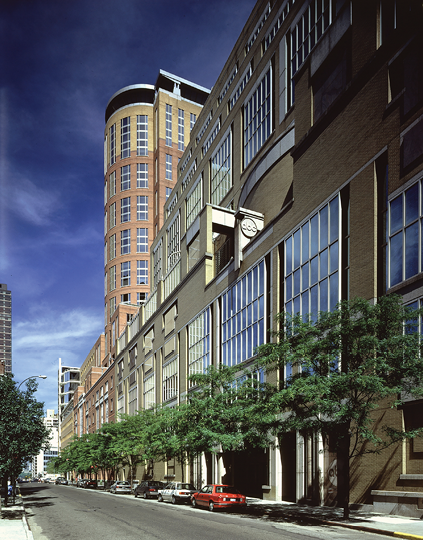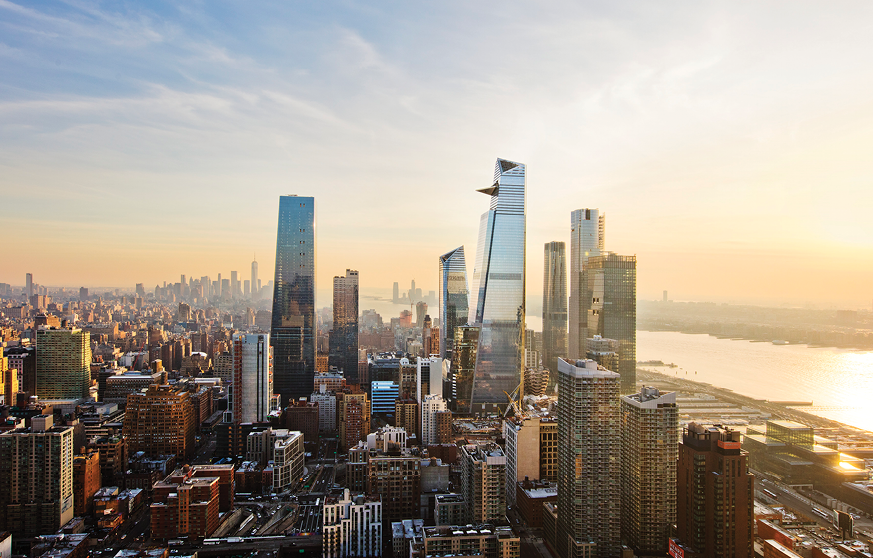- Home
- Media Kit
- Current Issue
- Past Issues
- Ad Specs-Submission
- Ad Print Settings
- Reprints (PDF)
- Photo Specifications (PDF)
- Contact Us

![]()
ONLINE

Built to Last
Editors’ Note
On July 4, 1976, A. Eugene Kohn founded Kohn Pedersen Fox Associates (KPF) in New York City, alongside William Pedersen and Sheldon Fox, with a commitment to outstanding design, quality of execution, and exceptional client service. The Founding Partners wanted to create a firm that would succeed well past their own tenures. With this in mind, they sought talented people who could be as good, and ideally better, than themselves. These employees, mentored by the founders, would be the next leaders at KPF – and hold the responsibility of doing the same for following generations. Today, Kohn serves as Principal and Chairman of Kohn Pedersen Fox. Holding Bachelor of Architecture and Master of Architecture degrees from the University of Pennsylvania, he served in the U.S. Navy on active duty between his academic degrees and, after graduation, remained in the Reserve for another five years, retiring as a Lieutenant Commander. Kohn is an Executive Fellow of the Graduate School of Design at Harvard University. He has taught at Harvard Business School for over ten years and at the Harvard Graduate School of Design for four years. He helped establish the Harvard Real Estate Center Academic Initiative, is a founding member of the Wharton School Real Estate Center Advisory Board, and has served for over 30 years on the Board of Overseers at PennDesign. Kohn was a trustee for the University of Pennsylvania and was honored with the 2010 Alumni Award of Merit by the university, the highest award presented to alumni. Kohn has also been recognized with the Wharton Real Estate Center’s Lifetime Achievement Award, the University of Pennsylvania – PennDesign Dean’s Medal of Achievement, the highest honor awarded by the institution, and the Ellis Island Medal of Honor.
Firm Brief
Kohn Pedersen Fox Associates (KPF) is one of the world’s preeminent architecture firms, providing architecture, interior, programming and master planning services for clients that include some of the most forward-thinking developers, corporations, entrepreneurs, and institutions in the United States and around the world. The firm’s extensive portfolio spans more than 40 countries and includes a wide range of projects from office and residential buildings to civic and cultural spaces to educational facilities. Driven by individual design solutions, rather than a predetermined style, KPF’s (kpf.com) mission is to create buildings and places of the utmost quality and contextual sensitivity, providing a valuable impact on the cities they inhabit.

ABC’s Armory Building on the Upper West Side
Will you highlight KPF’s history and heritage and what have been the keys to the firm’s growth and success?
Bill Pedersen, Shelly Fox and I started a new firm, Kohn Pedersen Fox, on July 4, 1976. That was a very important year in history, as it was the country’s 200th anniversary. It was also a very difficult year to start an architectural firm because we were in the midst of a bad economy. Most architectural projects had stopped and there was no new work for architects, particularly not for those who had just started a firm. Having looked through the history of companies that started in The Great Depression, we realized there were some advantages to starting in tough economic times – as things begin to improve, your company’s success would also rise with the tide. Also, during that time, potential clients had plenty of time to talk to us which gave us a chance to introduce our firm properly and get them interested in working with us when they did have projects. There was time to create relationships with new clients and reconnect with old clients we had not seen for a while.

ABC’s headquarters across from the
Armory on the Upper West Side
Large architectural firms at that time were pursuing work in the Middle East, particularly in Iran and Saudi Arabia so, in a way, there was little competition for projects in the States. We were very fortunate to be selected by ABC, which had just become the third major network along with CBS and NBC, to work on their project at the Armory on the Upper West Side of Manhattan. ABC also selected us to design the masterplan for their future development needs in the Upper West Side, which led to numerous projects for the company for which we were the architect. Soon after, we began the development of a new tower in Chicago called 333 Wacker Drive, which was an award-winning project. The client was Tom Klutznick, and we were selected thanks to our strong relationship with ABC. It was an amazing opportunity since rarely did New York architects work in Chicago, and certainly not unknown architects. An affiliate of ABC was a tenant in one of Tom’s buildings at the time, but was considering a move. He hoped our work with them would inform 333 Wacker’s design and lure them to Tom’s new building. Though the tenant ended up staying put, Tom loved the design so much that he moved ahead with the building.
So, despite a bad economy in which 60 percent of architects in New York were unemployed, we did well and put ourselves on the map with those successful early projects and strong client relationships. In the succeeding years, we were commissioned by Procter & Gamble in Cincinnati, The Federal Reserve Bank in Dallas, and we won a worldwide competition for the World Bank in Washington, D.C. As a result, our young New York office continued to grow with outstanding talent.
Building on this history, the key to our growth and success as a firm has been teamwork which encourages young people to grow and become leaders. We have a global reach and we are able to contribute outstanding architecture across the globe. We attract young people because we give them great opportunities to grow and succeed.

333 Wacker Drive in Chicago
How do you define the KPF difference and what sets the firm apart in the industry?
When Bill, Shelly and I founded the firm, we set three things as goals: One, to create a great firm. Two, to do outstanding architecture of all types, but primarily commercial, which we felt would enhance and contribute to our city life and the quality of architecture. Three, create a firm that offers strong opportunities for young architects to eventually become principals and leaders of the firm and that has happened, as today we have 34 principals led by our President, James von Klemperer, who has been with the firm for over 38 years. A key to this success is teamwork. We always think in terms of “we” and not “I” when it comes to our projects, highlighting the contributions of the group over the individual. This philosophy brings out the best in people and boosts team morale.

World Bank building in Washington, D.C.
How do you define KPF’s culture and what have been the keys to maintaining culture as the firm has grown in size and scale?
The original goal of the firm, to hire outstanding talent in order to create a great result, has been maintained throughout the firm’s history – and this is our 45th year. Each project we take on is equally important to the firm, and it has been that way from the beginning. The project teams, led by a design principal and a management principal, truly strive for, and achieve, excellence in the work. Through our robust education system, we continue to keep teams on the cutting edge which creates outstanding leaders in terms of design, management, and technology. In this way, and others, we provide great opportunities for young people to contribute to the firm and its projects, putting them on track to take on more responsibility as they grow at KPF. While the firm has a President, Chairman, and other senior leaders, there are significant leadership requirements across all levels – throughout the design process, and within the firm’s operations team as well. There are many opportunities for leadership on these teams and the success of the project depends on the individual’s abilities from a technical and design point of view. Excelling at the junior level gives staff opportunities for growth over time.
When Bill and I were still very active, we transformed the leadership – we have an outstanding Board which is made up of younger principals who are very successful at what they do. We want to set this example to inspire our staff and, through education and project experience, to continue to strive for growth in the firm.

One Vanderbilt in Midtown Manhattan
KPF is a global firm working in all parts of the world. How do you make sure to maintain close coordination between your offices and geographies and to work as one firm?
Project and firm leadership take place across all levels, so coordination among our project teams and others is critical. Before the pandemic, the leaders of our offices in New York, San Francisco, London, Berlin, Shanghai, Hong Kong, Singapore, Seoul and Abu Dhabi, would travel to New York to meet on a regular basis. Throughout the pandemic, we continue to rely on Zoom and phone calls to stay connected and have key meetings where we discuss different subjects. The leadership group connects monthly in focused leadership meetings, larger firm meetings and smaller team meetings. We are regularly in touch with each other and often have impromptu meetings as well. While this has worked very well, we look forward to reconnecting in person when we can travel again.
How critical is it for KPF to build a diverse and inclusive workforce and will you discuss the firm’s efforts in this regard?
Our workforce is extremely diverse, with many people from numerous countries across Europe, Asia, South America and the Middle East. We understand that in order to provide the best architectural solutions, our designers must be reflective of the populations they serve so we recruit and retain staff to that effect. Our firm is also fairly balanced between the number of men and women, but we know we still have work to do to ensure more women leaders represent KPF at the senior levels. Though men have traditionally dominated this profession, we are seeing a broader shift toward balance in architectural education as well. When I was a student, there were two women in my five-year class at University of Pennsylvania. Today, over half the program is made up of women. So, while the workforce in the profession today reflects the demographics in education many years ago, the future is currently reflected in today’s student body. I think this will continue so that in the future women will dominate the profession, and our firm continues to strive to enhance its diversity.

Hudson Yards on Manhattan’s West Side
What do you see as KPF’s responsibility to the communities it serves and to being a force for good in society?
All architects have a responsibility to be engaged with the issues facing the communities in which they work. At KPF, we understand that the built environment has an outsized impact on a community and we try to positively impact the places we work – from the city to the neighborhood, all the way down to the block – always keeping that in mind. Buildings have a lasting impact on their communities and we design our work to stand for decades. A project’s design and plan must work not only for the intended purpose of the current user, but must also contribute to the surrounding context and be flexible in future use.
Beyond our work on projects, through charity and mission-driven initiatives, our firm and our employees leverage a multitude of backgrounds and interests to influence change in the field.
What are the keys to New York’s recovery and rebuilding from the pandemic?
One of the keys to New York’s recovery is to reestablish confidence in the transportation system which is one of the great assets of the city. Once visitors and locals feel more confident about their safety on subways, buses, etc., they will be more inclined to visit all of the great institutions, attractions, restaurants, shops and other destinations New York has to offer. This will spur a strong economic recovery that will lift small businesses and those who are employed by them. As business improves and as tourists return, the city will once again become the great attraction to those around the world.
Another important component in our recovery that should not be overlooked is climate change. It is the single biggest issue facing our city and country right now, so our job is to shape new buildings and infrastructure to be sustainable and minimal in their impact on the environment.
What advice do you offer young people interested in a career in the industry?
One, they need a good education, so I recommend going to an excellent school to learn about the profession. After that, they need to work for a good firm, small or large, to learn about the different phases of work – designing, creating working drawings, and all of the aspects of a professional practice. Working at a firm can give one a different kind of education in terms of process, so I recommend getting as involved as possible in projects and learning what it means to work on a team in a professional setting.
I graduated from the University of Pennsylvania after a five-year course, and was an Officer in the Korean War for the US Navy. Afterwards, I went back to Penn for graduate school and studied with great architects like Paul Rudolph, Lou Kahn and others. The discipline and the decision-making abilities of military service played a key role in my life, teaching me valuable skills about leadership and how to make the correct decision quickly. Shelly Fox was also an army officer at the same time, and he benefited from this lesson as well. One had to be decisive at that period of time – you often would have only seconds to make a decision that could potentially save many lives. This quick thinking is helpful in business.![]()